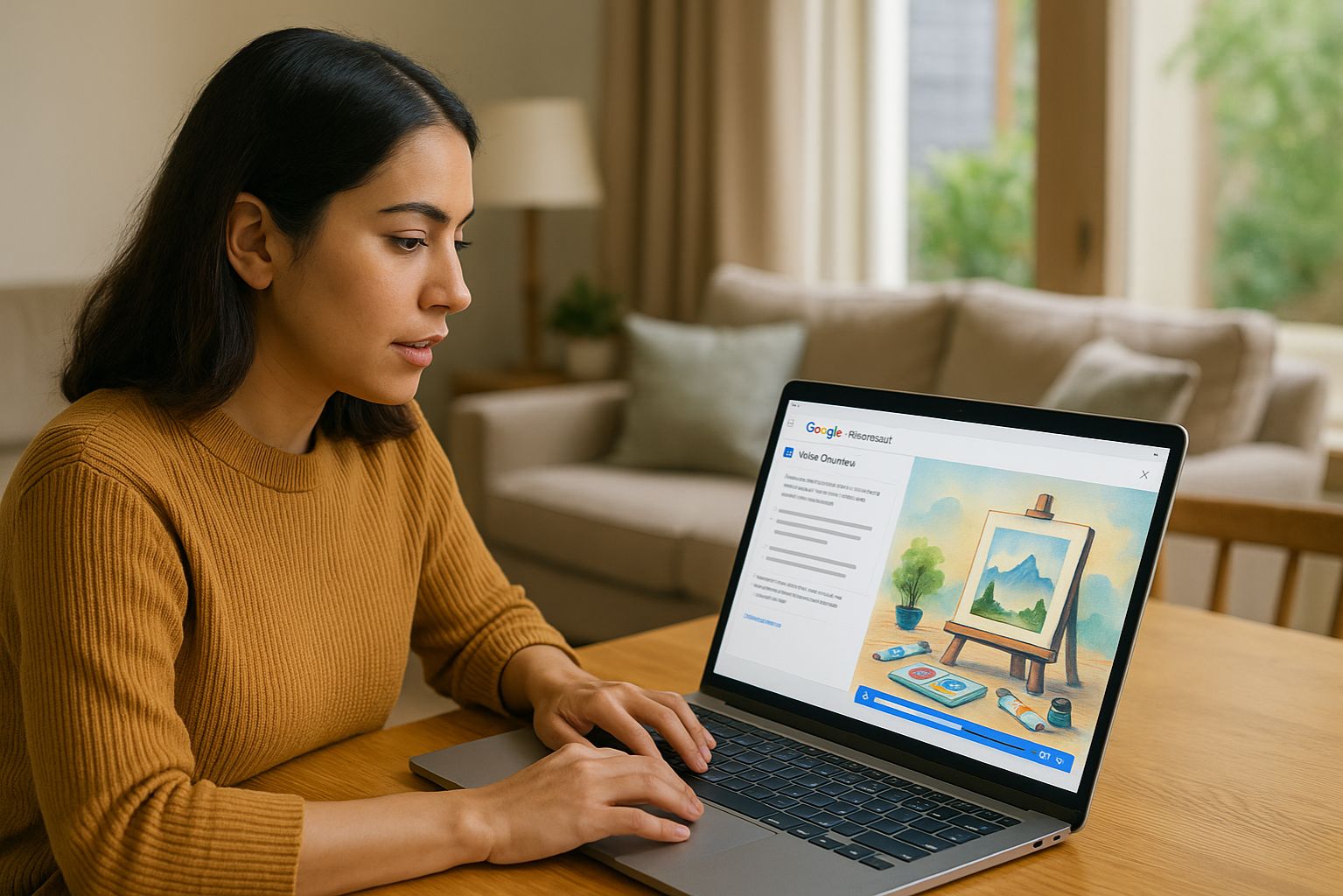
A user creates a NotebookLM Video Overview with help from Google’s Nano Banana image generation model. Image Source: ChatGPT-5
Google Expands Nano Banana AI to NotebookLM, Search and Photos
Key Takeaways: Google Expands Nano Banana Across Its AI Ecosystem
Google’s Nano Banana image generation model expands to NotebookLM, Search, and soon Photos.
NotebookLM’s Video Overviews get major upgrades with six new visual styles and two new video formats.
Users can now generate Explainer or Brief video summaries directly from their notes or uploaded sources.
AI-powered Discover and Search updates improve content discovery and real-time sports tracking.
Rollout begins this week for Pro users, expanding globally in the coming weeks.
NotebookLM: Turning Documents Into Dynamic Videos
Google is rolling out a significant upgrade to NotebookLM’s Video Overviews, introducing a creative boost powered by Nano Banana, the company’s latest image generation model derived from Gemini 2.5 Flash.
The update transforms how users engage with dense documents. NotebookLM’s Video Overviews feature—previously a tool for generating narrated summaries—now produces richly illustrated, customizable videos designed to make information easier to absorb and remember.
The Nano Banana model, already used to create more than 5 billion images in the Gemini app, now generates contextual and visually appealing illustrations directly from a user’s uploaded sources.
Visual Styles and Customization Options
Each new Video Overview can automatically adopt one of six new artistic styles: Watercolor, Papercraft, Anime, Whiteboard, Retro Print, or Heritage.
Users can also select between two new video formats:
• Explainer: A structured, comprehensive summary offering in-depth understanding.
• Brief: A short, focused version that highlights key takeaways for quickly grasping core ideas.
Customization options allow users to target specific content within a document. For instance, they can instruct NotebookLM to “focus only on the cost analysis sections of the business plan” or “convert these recipes into an easy-to-follow video emphasizing prep time and cooking steps.”
The process is designed for simplicity—users select their sources, click Video Overview, choose a style and format, and then let NotebookLM generate the narrated video automatically.
NotebookLM: How to Create a Video Overview
After exploring the new visual styles and customization options, users can easily apply them when creating a Video Overview in NotebookLM.
Select your sources: Choose the notes, documents, or uploaded materials you want to visualize within NotebookLM.
Click “Video Overview”: The feature will appear as a tile in your notebook interface.
Customize your video: Tap the pencil icon to open customization options. You can select between Explainer or Brief formats, choose one of six visual styles, and even direct the focus of the video with natural-language instructions such as “Highlight the cost analysis sections of this business plan” or “Convert these recipes into an easy-to-follow video showing prep time and steps.”
Generate and view: Once your preferences are set, NotebookLM automatically produces a narrated video summary. You can continue exploring your notebook while the video is created, then review or share it once rendering is complete.
Expanding Nano Banana Across Google Products
Beyond NotebookLM, Nano Banana is now integrated into Google Search and will soon reach Google Photos. The move broadens access to Gemini’s image generation capabilities across the platforms where users already research, learn, and create.
In Google Search, users can now create images directly through Lens using the power of Nano Banana.
Simply snap a new photo or select one from your gallery.
Then tap the new Create mode in the Google app on Android or iOS.
The system instantly analyzes your image and generates a transformed, AI-enhanced version based on your prompt or visual intent. Whether you want to reimagine a photo’s style, adjust background details, or explore creative variations, Lens now acts as a visual creation tool—bringing generative capabilities straight into the search experience.
Google says this rollout continues its mission to make information “more accessible and useful by transforming dense information into dynamic multimedia that helps people understand complex topics in new ways.”
Search and Discover: Smarter Ways to Stay Updated
In parallel, Google Search and Discover are gaining new AI-powered features that use generative capabilities to surface timely, personalized content.
In Google Discover, an upgraded feature now highlights trending topics with expandable previews and links to related stories from across the web. According to Google, testing shows this approach helps users engage with a broader range of publishers and creators. The feature is currently available in the U.S., South Korea, and India.
Meanwhile, a new sports update feature in Google Search introduces a “What’s new” button for players and teams. When tapped, it reveals a feed of trending updates, stats, and articles—helping fans stay current with live developments. This feature will begin rolling out in the U.S. over the coming weeks.
Q&A: Nano Banana’s Expansion and Impact
Q1: What is Nano Banana, and how does it relate to Gemini 2.5 Flash?
A: Nano Banana is Google’s latest image generation model, built on Gemini 2.5 Flash. It enables realistic, creative visuals that can be embedded into products like NotebookLM and Search to enhance how users engage with information.
Q2: How does Nano Banana improve NotebookLM’s Video Overviews?
A: It generates contextual illustrations directly from uploaded sources, transforming static summaries into narrated, animated explainers that help users better visualize and retain information.
Q3: What new customization options are available for Video Overviews?
A: Users can choose between Explainer and Brief formats, select from six visual styles, and even direct focus areas—such as highlighting specific sections or simplifying complex steps in a process.
Q4: What’s changing in Google Search with Nano Banana and Lens?
A: Through Lens, users can now snap or upload a photo, activate Create mode, and let Nano Banana transform images using AI, turning Search into a creative tool for visual exploration.
Q5: Why does this update matter for the future of AI tools?
A: It shows Google’s push toward multimodal AI experiences, where text, images, and video generation work together to make complex ideas more accessible and engaging for all users.
What This Means: The Rise of Visual-First AI
Google’s expansion of Nano Banana across NotebookLM, Search, and soon Photos signals a decisive step toward making multimodal AI a default part of everyday computing. By merging visual generation, summarization, and contextual understanding, Google isn’t just adding features—it’s redefining how people interact with information.
In NotebookLM, the integration of Nano Banana turns static text into narrated, illustrated stories, helping users retain complex material through visual memory and storytelling. This approach bridges the gap between learning and creation, demonstrating how generative AI can function as both an educator and a creative assistant.
For Search, Nano Banana’s arrival through Lens shows Google’s vision for the next phase of information discovery—one where users can start with a photo, document, or idea, and let AI instantly generate context, visuals, and meaning around it. It’s a shift from typing queries to communicating visually with the web.
Together, these moves reflect a broader industry trend: AI systems are becoming more multimodal, intuitive, and context-aware. Rather than serving as separate tools, they’re blending into the natural workflows of learning, research, and creativity.
If successful, Google’s approach could reshape how users expect to process information—turning once-passive reading or searching into an interactive, visual-first experience that bridges understanding and imagination.
It’s a sign of where everyday tools are heading—toward a future where creativity and comprehension converge through AI.
Editor’s Note: This article was created by Alicia Shapiro, CMO of AiNews.com, with writing, image, and idea-generation support from ChatGPT, an AI assistant used for research and drafting. However, the final perspective and editorial choices are solely Alicia Shapiro’s. Special thanks to ChatGPT for assistance with research and editorial support in crafting this article.

